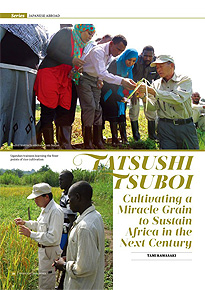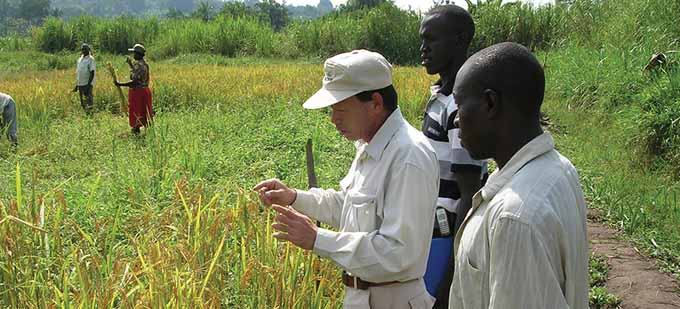Home > Highlighting JAPAN >Highlighting Japan September 2014>Japanese Abroad
Highlighting JAPAN

Japanese Abroad
Tsuboi Tatsushi
Cultivating a Miracle Grain to Sustain Africa in the Next Century

Aprimarily agrarian nation in East Africa situated high above sea level, Uganda is blessed with abundant water, fertile soil, and a mild, pleasant climate despite being just south of the equator. For this, Winston Churchill once called the country the "Pearl of Africa."
Over ten years ago, the Japan International Cooperation Agency (JICA) launched the NERICA Rice Promotion Project for Hunger and Poverty Reduction in Uganda. "We believed we could conduct research and training on rice throughout the year in this country," JICA rice expert Tatsushi Tsuboi says.
Tsuboi works at the National Crops Resources Research Institute located near Lake Victoria in Uganda's capital city of Kampala. He leads the research into and efforts to introduce New Rice for Africa (NERICA), together with Ugandan researchers and staff members, the Japan Overseas Cooperation Volunteers (JOCV), and Japanese experts conducting ongoing research on rice production in Africa.
NERICA rice is the progeny of high-yield Asian rice and disease- and drought-resistant African rice. NERICA can be grown in upland fields instead of paddy fields, and is compatible with Africa's agricultural environment and practices. It grows faster than lowland rice, and crop yields are two to three times higher than conventional African rice. NERICA is seen as a way not just to solve food crises but also to improve economic conditions for farmers.
The staples of the Ugandan diet are cassava, corn, sweet potatoes and bananas. Rice is still a luxury foodstuff, eaten primarily on holidays and ceremonial occasions, and Uganda imports sixty thousand tons of the grain from Asia. High-yield NERICA rice has the potential to become a major cash crop and offer a better dietary lifestyle.
Improving rice production in Uganda meant practically starting from scratch. Having never seen rice plants before, local researchers initially mistook them for weeds. Unaware that rice grows better with more water, farmers wrongly assumed rice plants would wither if water collected in the fields. They needed to be taught to consider detailed rainfall surveys and differences in climate and soil among regions when choosing the variety of rice as well as the method of cultivation. A farming family without the proper knowledge or equipment would also need to secure methods for threshing and milling the rice after the harvest.
Tsuboi visits fields constantly to lead and instruct, and at becomes overly passionate. "I refuse to provide irresponsible support," Tsuboi says. "We want to show them all the best technology and skills we have. I believe that's my job as a JICA expert, and the true meaning of agricultural support."
Cultivated areas for rice production have expanded from 10,000 hectares when the project first began ten years ago to 160,000 hectares. NERICA rice now accounts for a third of all rice harvested in Uganda.
Known affectionately as "Mr. Nerica" in Uganda, Tsuboi was named one of Newsweek's "100 Most Respected Japanese People in the World" in 2009. He is retiring this fall, and will be returning to Japan after twenty years of being actively involved in rice cultivation in Uganda and other African countries such as Ivory Coast and Ghana. During his career, he has trained nearly a dozen young Japanese experts in the field. "When working in the international cooperation sphere, I've always believed that it is most important to work up a sweat alongside your counterparts," he says.
The initiative for better rice production has begun in Africa, but continuous support is needed to sustain the movement. Tsuboi dreams of a day, perhaps a century from now, when rice production is flourishing throughout Africa, and that as people there consume rice with their daily meals they might say, "the Japanese people taught us how to grow better rice."
© 2009 Cabinet Office, Government of Japan






